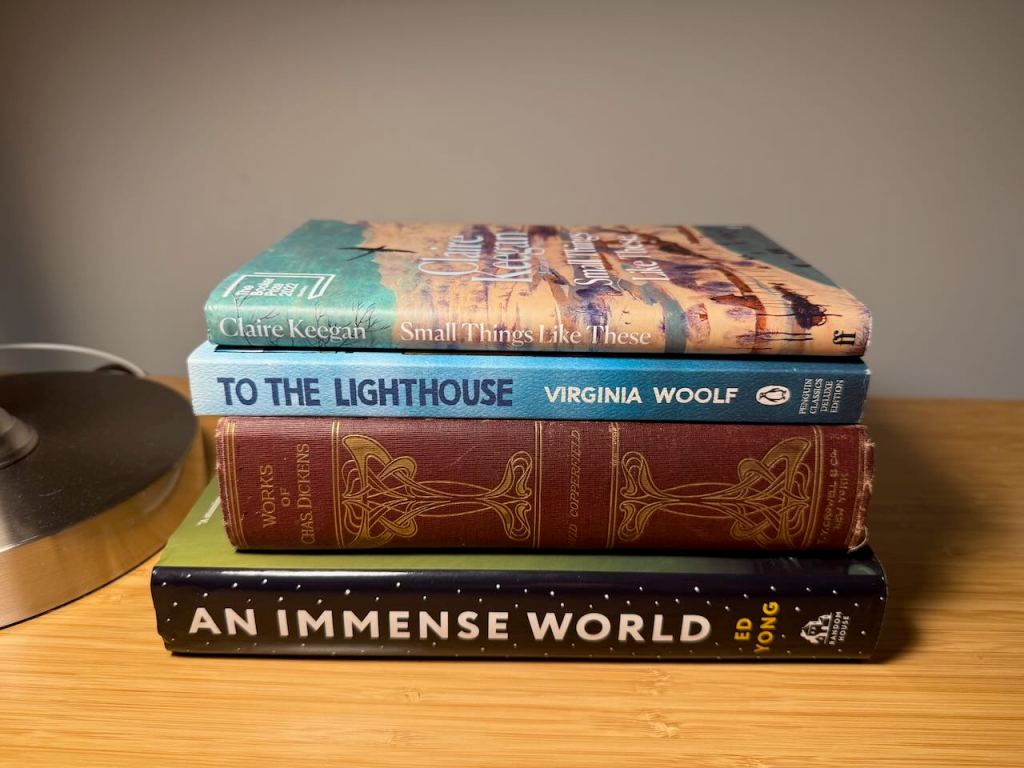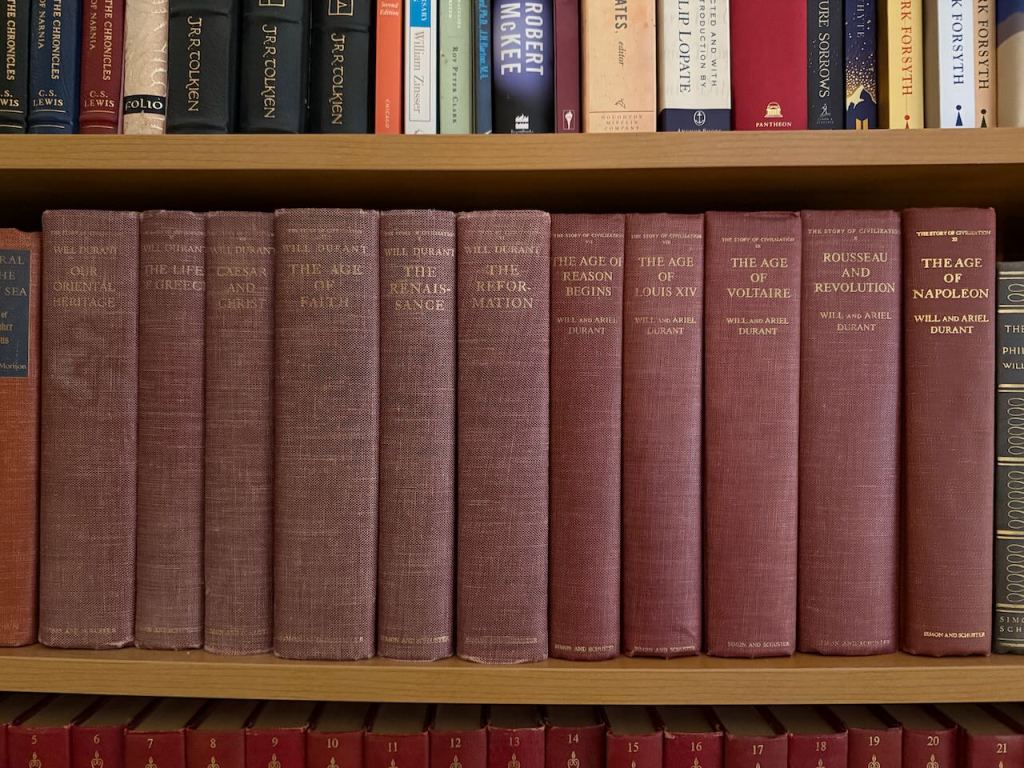I read 53 books last year, split about evenly between physical and e-books, and listened to just one audiobook. I usually listen to 10 -15 audiobooks a year, but in 2024, I decided to leave the AirPods behind on long walks to be more present. This felt like a fair exchange.
Favorites
The best non-fiction book I read last year was An Immense World by Ed Yong. The book shares how other animals sense the world in ways humans cannot. The book covers dozens of species, from an elephant’s incredible sense of smell to how spiders sense and surf on electric charges in the Earth’s atmosphere. You can’t read these amazing stories without shifting uncomfortably in your chair. We think we understand reality but are too limited by our senses. We are not seeing the whole picture. This is a mind-expanding book.

My favorite novels spanned three centuries:
Small Things Like These by Claire Keegan is a short, spare novella written in 2021 and set in 1980s Ireland. In just 109 pages, Keegan puts you squarely in the mind and body of its protagonist, Furlong. You feel the pangs of long-ago childhood angst, the chill of an Irish cold spell, the ugliness of small-town bigotry, the warmth of a coal stove, the despair over human cruelty. The Irish dialogue rings out like music or birdsong, making me wish American English wasn’t so flat and ordinary. I felt sad to leave Furlong’s side after so short a visit and longed to know what happened next, but the tale and ending were told in just the right way, with just the right words. Keegan is a poet masquerading as a novelist.
To The Lighthouse by Virginia Woolf had been on my to-read pile for years. I was leery of the stream-of-consciousness writing style, and its Goodreads reviews were concerning. Yet I loved it. Perhaps it wouldn’t have clicked with me if I had read this book ten years ago. Sometimes, a book finds you when you’re most ready for it. I was ready. No spoilers, but prepare to be gutted in the second half. You can judge the impact of a book on how long you think about it after you’ve read it. Eight months later, and I am still thinking about this one.
Finally, I adored David Copperfield by Charles Dickens. I read this as homework for the highly touted Demon Copperfield by Barbara Kingsolver, a modern retelling of this classic. Stepping into a Dickens novel requires a certain faith that the vocabulary and style and flood of characters will eventually make sense. My head spun with each new character, some appearing for such a short visit that I complained to myself that Dickens was being indulgent. I should have known better. By the end, no matter how minor, every character returned, and I understood their part in the story. Sure, this involved unlikely coincidences for our protagonist, but I loved the resulting tapestry of those many loose threads woven together. After spending almost 900 pages with these characters, some incredibly kind, some evil, I felt reluctant to part with them. Reading the book right ahead of Demon Copperfield made it feel like Kingsolver wrote high quality fan fiction. Dickens was indeed a true master.
The Story of Civilization — A Marathon, Not a Sprint
In 2024, I continued my multi-year reading of Will and Ariel Durant’s epic eleven-volume Story of Civilization. I read six more books, taking me from Renaissance Italy to the eve of the French Revolution in late 18th-century Europe. I should complete this journey in early 2025 with final volume, The Age of Napoleon. I’ll write a follow-up review of my takeaways from the complete series when I finish volume XI, but for now, let me say that the experience has been incredibly rewarding.

Stephen King — Scraping the Bottom of the Barrel
I have read more Stephen King novels than any other author, dead or alive. Last year, I vowed to tackle the ones I missed to read all 75 of this amazing storyteller’s works. I read three more from his backlog in 2024, none of which hit the mark. I have another twelve more books to complete this quest, but my enthusiasm has waned. I guess there was a reason I didn’t read these last books: even the greatest writers have their duds. However, his latest book of short stories, You Like It Darker, was fantastic. Some writers truly do get better with age.
My Reading System
I use the Bear note-taking and writing app to keep my reading notes and links to my personal note system. I switched over from Craft at the beginning of 2024, and I have been pleased with the added capabilities and aesthetic sensibilities of Bear.
I use Readwise to collect and review notes and highlights from my reading. Last year, I added over 700 new highlights to the system for a total of 2,400 collected passages.
I started using tags in Readwise about midway through 2024. I’m not sure why it took me so long. During a morning review of random highlights, adding one or more tags to a passage is simple. Tagged quotes accumulate into a digital commonplace book within Readwise, almost replicating what I have in Bear. Sharing a beautifully formatted quote from Readwise is easier and better than anything I could do from Bear:

The Readwise app hasn’t received any new features in years, as the team has focused almost exclusively on its read-it-later app, Reader. However, a recent Reddit comment from a member of the Readwise team shared that significant improvements are coming in 2025. I’m heartened to know they haven’t forgotten the humble book in their quest to dominate online reading.
In addition to Bear, I store my book notes in a Day One reading journal. I love how easy it is to review the books I’ve read in the timeline view or see the book covers of all the books in the media view. I’ve imported seven years worth of book notes, so the “on this day” review in Day One shows the books I read alongside my journal entries. It’s another great way to reflect on my reading.

The Great TBR Reset of 2025
Over the holidays, I reviewed my ever-growing To-Be-Read list of books. All serious readers have a TBR, and mine had grown so large that I realized I would never get to all of them. I decided it was time for a purge.
Out of a list of 400 books, I marked each with my current interest level: low, medium, high. When I finished, I had narrowed the list to just 50 books, each of which I’m genuinely excited to read. I could work through the entire list in a year, though I know I won’t. It’s impossible to resist that perfect book that comes out of nowhere. Still, looking at my TBR list with more excitement than dread feels much better. If your TBR list has gotten out of hand, the new year is a great time to consider a reset.
Happy reading in 2025!
Discover more from Robert Breen
Subscribe to get the latest posts sent to your email.




Hello Robert, thanks for sharing. I feel like I really need to read an “Immense World”. Happy Reading in 2025 too! 🖐🏾
Ha! Now your TBR list is growing! It really is a fascinating book. Happy new year!
I was so excited to get notified of a new post! I always enjoy reading your thoughts. This year I read 39 books and also shared some thoughts on my blog. I had a weird experience this year when reviewing all my books read: I couldn’t remember reading one of them. I thought maybe I just wrote it down but didn’t actually get to it, but then I saw my highlights and realized I had in fact read it. Not sure why it seems nothing stuck from that book at all.
Also, I was interested to see you mention Day One and seeing journal entries. Have you migrating journaling back to Day One from Bear? Or are you using them in tandem?
Thank you, Brandon! Nice reading list and great blog! I love your birthday dress tradition.
For journaling, I’m using Day One and Bear in tandem. I use Day One for the actual journal writing and to access journal reviews like on this day and maps. I found I write better and more honestly with Day One. No links, no back-links, no other knowledge notes to distract me — just a blank screen. I had this same epiphany when I tried to use Craft. I am a slow learner! Once a week, I archive my Day One posts to Bear, add appropriate links, etc. Searching and discovery in Bear is far superior. For me, it’s the best of both worlds.
Hope you have a great new year!
Hi Robert,
I dump all kinds of things/mementos into Day One—emails, voice recordings, pictures. For example, this morning, my mom sent me a voice recording on WhatsApp with a recipe, and I added that to Day One.
Are your Day One journal files just text files? Do you export them as Markdown and import them into Bear?
Since I just started using Bear, I’m still figuring out my workflow. I like the idea of a backup from Day One, but my ‘journaling method’ feels like it would clutter Bear. I also feel the same way about not wanting to link, backlink, or prod my journal entries.
Like you, I put everything in Day One: photos, videos, some audio, and the occasional PDF. Saving audio from your mom is a great idea. I wish I had recorded some audio from my mom and stuck it in here before she passed.
I write my journal in Day One and consider it the one source of truth. Weekly, I import last week’s entries into Bear as a linkable and searchable archive (Bear searches inside photos and PDFs and has more powerful search capabilities overall than Day One).
I’ve automated the process of the import, so it only takes me about two minutes each week.
Here are the steps:
* Day One: Export selected entries to JSON
* Bear: Import entries from Day One (first line as title, escape involuntary tags)
* Bear: Export these same entries as markdown to the Journal Processing folder
* Hazel: Automatically renames journal files to the creation date and time
* BBedit: run a Text Factory Script that cleans up some clutter from the import
* Bear: Import transformed entries as Markdown (file name as title, keep original dates, do not escape tags)
* Bear: delete the folder tag that came with the markdown import.
I’ll admit, as I type out these steps, it might seem like overkill. But everything comes over perfectly from Day One, including all the media. It’s nice to have a backup, and it’s helpful when I’m writing up a book note or thinking about a blog post to have all my journal writing available.
I hope this makes sense!
Bob,
Happy New Year!
We think of you often.
Joe
Chinese Proverb – \”Now is the time you own; the past is a golden link. Go fishing my brother, it is later than you think!\” <º))))><
>
Hi Robert, enjoyed this piece. It prompted me to do book reviews as well in DayOne. Question how did you get the star rating? Is it a font, and icon, etc? Thanks.,
Hi Jon,
The star ratings use these universal star characters:
★★★★★
★★★★☆
★★★☆☆
★★☆☆☆
★☆☆☆☆
You should be able to copy and paste these yourself. I have these programmed into a Keyboard Maestro macro for my use with Day One. But for writing on-the-fly book reviews, I use keyboard replacements on iPad, iPhone and Mac. That way when I type 5star I automatically get ★★★★★.
Hope this helps!
Hi Rob,
Really pleased to see your blog post pop up on my RSS feed, as I always like to read what you write.
I would be very interested to know more about your Readwise to Bear workflow for your reading notes. Do you use some work-around to import, given that there is no direct import feature? Or are you doing it manually? How do tags across the systems interplay?
With best wishes for a Happy New Year.
Hi Matthew,
Thanks for your note. I’m using Obsidian and its Readwise plugin to get my reading highlights into Bear. I experimented with an Apple Shortcut, but I didn’t like the way it cluttered up my notes in Bear. I have the Readwise plugin set to sync highlights automatically when I open Obsidian, so it’s pretty seamless. And it’s the only thing I use Obsidian for.
Tags I apply in Readwise are converted to note links in Bear (via Obsidian) so long as those tags are applied before they get imported. It works really well.
Hope this helps. Thanks for reading!
Bob
Thanks Bob. That’s really interesting. Do you use the direct Obsidian to Bear import feature in Bear?
Great question. I do a simple copy and paste from Obsidian into Bear. Obsidian’s markdown text and link format comes over perfectly in Bear. I’ve come to appreciate keeping the raw highights download separate from the working book note. When I’m working on the note for a book I’ve just finished, it takes me a while to sift and sort through all my notes and highlights. I’ll group some passages together as a theme, delete others, and bring in notes I may have written in my journal about the book. It’s a messy process. Honestly, if Readwise and Bear were integrated, I’d worry that new downloaded highlights would muck up my literature note.